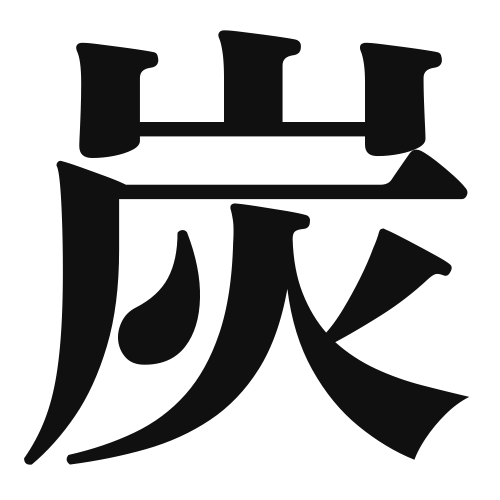1. Overview of Meaning
The kanji “炭” (pronounced “sumi” in Japanese) means “charcoal.” It refers to a black, porous material made from burning wood or other organic substances in the absence of oxygen. Charcoal is commonly used for cooking, heating, and even in art.
2. Formation and Radical
Formation of the Kanji: The kanji “炭” is a phonetic-ideographic character (形声文字). It combines the radical for “fire” (火) with a phonetic component that suggests its pronunciation.
Radical: The radical of “炭” is 火, which relates to fire, indicating its connection to the burning process used to create charcoal.
3. Examples of Usage
Common Words and Phrases: Some frequently used words that include “炭” are:
- 炭火 (すみび, “sumibi”) – charcoal fire
- 木炭 (もくたん, “mokutan”) – wood charcoal
Example Sentences in Daily Conversation:
- バーベキューには炭を使います。 (ばーべきゅーにはすみをつかいます。) – We use charcoal for the barbecue.
- この炭はとても良い品質です。 (このすみはとてもよいひんしつです。) – This charcoal is of very good quality.
4. Synonyms and Antonyms
Similar Kanji: A similar kanji is “石炭” (せきたん, “sekitān”), which means “coal.” While both are carbon-based fuels, “炭” refers specifically to charcoal, while “石炭” refers to coal, which is mined from the earth.
Opposite Kanji: An antonym could be “水” (みず, “mizu”), meaning “water,” as it represents a liquid that is the opposite of the solid form of charcoal.
5. Cultural and Historical Background
Connection to Japanese Culture: Charcoal has been used in Japan for centuries, not only for cooking but also in traditional arts such as ink-making and calligraphy. It is valued for its ability to absorb odors and purify air.
Proverbs and Idioms: One common saying is “炭火のように熱い” (すみびのようにあつい, “sumibi no yō ni atsui”), which translates to “as hot as charcoal,” often used to describe a passionate or intense feeling.
